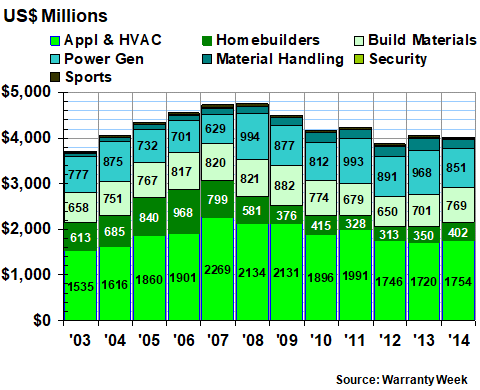Twelfth Annual Product Warranty Report:
Warranty expenses are once again rising and so are the associated expense rates. Much of that has to do with the increased cost of passenger car recalls, and some of it is caused by the soaring sales of smartphones. But could it be that some of the most successful warranty cost-cutters have let things slip back a little recently?
Way back in 2003, following scandals in which crooked companies did everything from booking bank loans as sales revenue in Buffalo to manipulating the supply of electricity in California, a new accounting rule was written to force all companies to reveal the size and scope of all the guarantees they'd made. Fortunately, one of the types of guarantees they had to disclose was their warranty expenses.
Suddenly, what had been a confidential topic became public knowledge, with warranty expenses included in the annual reports of hundreds of American manufacturers. Over time, we began to understand what was a normal expense rate for a given company, product type, or industry, and by referencing against that baseline, we could tell when a manufacturer was in trouble.
Twelve years later, the data on warranty claims, warranty accruals, and warranty reserves can be sliced and diced to reveal which companies are cutting costs the most, and which are seeing their costs soar out of control (see last week's newsletter for a list). But this week, we wanted to go over the top-level industry totals and averages for these three warranty metrics, in advance of a months-long series of industry-by-industry close-ups.
Claims Payments
Let's start with claims payments. In 2014, U.S. manufacturers paid $26.7 billion in claims worldwide. In 2008 they paid $29.5 billion in claims, and last year they paid $26.1 billion paid in claims.
But they also sold more products last year than they did in 2008, and those products sold last year were more reliable than they were seven years ago. So the amount paid in claims represents a smaller share of overall revenue than before, even though the totals were about the same.
In Figure 1, we've charted the past 12 years in claims payment totals, dividing all the manufacturers into one of 17 different industries. It's clear that the automotive OEMs are the largest group, followed by computers and then a three-way tie between aerospace, appliances, and automotive parts suppliers.
Figure 1
Worldwide Warranty Claims
of U.S.-based Companies
(claims paid in US$ millions, 2003-2014)


We've used shades of blue to highlight the vehicle makers; shades of red to highlight the high-tech electronics industries; and shades of green to highlight the building trades. Roughly speaking, this is it. There are no other industries issuing product warranties or paying claims.
This year, we divided what used to be the "other" category into three more slices: material handling equipment, security equipment, and sports equipment. With some stretches of the imagination (placing watches into sports equipment, guns in security equipment, etc.) every U.S.-based manufacturer that reported paying warranty claims in 2014 is now in one and only one of 17 industry categories.
That creates a bit of a problem, as we shall explore in more detail in the weeks ahead. For instance, Eaton is counted under the auto parts heading, not aerospace. United Technologies is in appliances/HVAC, not aerospace. So the aerospace slice is smaller than it should be, if warranty claims were truly sorted by product instead of by company.
Worldwide claims payments totaled $26.1 billion in 2013, so there's been a 2.2% increase in claims payments in 2014. We're still waiting for a few stragglers such as Associated Materials LLC and PGT Inc. to file their 2014 annual reports, but they're not expected to change the overall totals appreciably. While we wait, we're inserting placeholding estimates for these late-filers.
Warranty Accruals
The fraternal twins of warranty claims are warranty accruals, and we're counting those in Figure 2. These are the amounts a company sets aside at the time a product is sold, in order to finance the future cost of their product warranties. Claims, on the other hand, are the bills you pay for fixing products sold during other periods. So while there's always some lag time between sales and claims, there's no lag time between sales and accruals. One causes the other.
That's why in Figure 2 there's an even more obvious recessionary notch in the data during the years 2008-2011. Accruals closely follow sales trends, so when sales of cars and homes tanked in 2008-09, so did accruals. In contrast, what we see in Figure 1 are the more or less continuing demand for free repairs, which possibly became even more important as customers held onto their products longer because replacement purchases became harder to finance.
Figure 2
Worldwide Warranty Accruals
of U.S.-based Companies
(accruals made in US$ millions, 2003-2014)


U.S.-based manufacturers set aside just over $28.5 billion in warranty accruals in 2014, up about 3.2% from 2013 levels. However, that's still a bit below the pre-recession record of $30.2 billion set in 2007, although perhaps we should be a bit reluctant about celebrating the record high for an expense. For instance, the big jump in accruals by the auto OEMs can be traced to their increased recalls. And the reason for those recalls involved not only injuries but also deaths.
In future weeks we'll take apart these numbers in more detail, industry by industry. But the other obvious change in the accrual data is the decline in the computer category. While the auto OEMs raised their accruals from $8.5 billion to $11.3 billion, the computer makers cut their accruals from $8.8 billion to $7.0 billion.
Part of the reason for that is the disappearance of Dell Inc., which went private in 2013 and ceased reporting its warranty expenses publicly. And part of it is cost reductions made by Apple, though most of those probably came from the iPhone product line, not the Macintosh computer family.
Warranty Reserves
In Figure 3, we're tracking the balance in the warranty reserve funds of all the U.S.-based manufacturers paying claims and making accruals. We smashed the record in 2014, with reserves soaring 11.8% to $44.5 billion by the end of 2014.
Monetarily, most of that increase came from Apple and the top U.S.-based auto OEMs: GM and Ford. But the upward trend was more widespread than that, with auto suppliers such as Cummins, BorgWarner and Johnson Controls also raising reserves, along with heavy equipment makers such as Caterpillar, Paccar and Deere, appliance makers such as Whirlpool, and aerospace companies such as General Dynamics and Textron.
Figure 3
Worldwide Warranty Reserves
of U.S.-based Companies
(reserves held in US$ millions, 2003-2014)


Notice that the automotive share of the reserves in Figure 3 is greater than their share of either the claims in Figure 1 or the accruals in Figure 2. That is not an optical illusion. Typically, the vehicle industries account for roughly half of all claims and accruals, while the high-tech electronics industries account for roughly a third of all claims and accruals. But the vehicles account about 60% of all reserves, while the high-tech categories account for less than a quarter.
In 2014, that ratio widened even further, because of the buildup of reserves prompted by all the passenger car and light truck recalls. The vehicle categories accounted for 59% of reserves, while the high-tech categories accounted for only 25%. The building trades accounted for the remaining 16%.
As we will see in the weeks ahead, one big reason for the difference is the relative length of the warranties in each category. Most high-tech warranties last for a year or two. Most vehicle warranties last much longer. So those manufacturers need to keep higher balances, because the payments will continue for longer periods.
Warranty Expense Rates
Another way the cost of warranties in different industries can be measured is as a percentage of product sales. A $20,000 vehicle might come with a warranty that's expected to cost its manufacturer around $400 over the life of its warranty. The warranty on a $400 television might be expected to cost $8.00 over its one-year length. Both would equate to an accrual rate of two percent *warranty cost divided by product cost).
In Figure 4, we've taken all the U.S.-based manufacturers covered in Figures 1 and 2 and divided their total claims and accruals by total product sales, to calculate a pair of percentages for their average claims and accrual rates. For multiple years, we were always delighted to be able to report that these percentage rates were falling, as manufacturers cut costs, made their warranty processes more efficient, and made more reliable products.
But we had to stop saying that in 2012, as the industry average claims and accrual rates stopped falling. And we became worried in 2013 as those expense rates began rising. Now, with the 2014 data collection almost completed, it's getting downright scary, as expense rates rise back to 2009-2010 levels.
Figure 4
All U.S.-based Companies
Average Warranty Claims & Accrual Rates
(as a % of product sales, 2003-2014)

What's causing this trend reversal? We can't yet say for sure, but it's probably related to the GM, Ford and Chrysler recalls, and to the roaring sales of the Apple iPhone. In other words, it's partially a drop in reliability (of passenger cars), and partially a rise in sales of warranty-intensive products (such as smartphones).
That 2009 spike in the claims rate was caused primarily by the drop in car sales, which as Figure 1 illustrates, was not accompanied by much of a drop in claims payments. Since the claims rate is calculated by dividing claims by sales, it soars when sales plummet.
But note that the 2009 spike in the claims rate was not accompanied by a rise in the accrual rate. That's because accruals are made only when a sale occurs, so if there are no sales there are no accruals. In contrast, even when there are no sales this year, some of last year's customers will still be seeking warranty work.
This time, both the claims and accrual rates are rising. And the accrual rate in mid-2014 hit levels not seen since the middle of 2007. That means some CFOs and the warranty-finance professionals who set the accrual rates are worried about repair costs in the future. And it means that at least for now, 2012 may be the peak in terms of high-reliability products and low warranty costs.
Industry by Industry
In Figures 5 through 7, we simply want to put some numbers to the claims costs seen in the various industry categories. In Figure 5, we've charted the three vehicle categories: the auto OEMs, auto suppliers, and aerospace manufacturers. As mentioned, these categories account for roughly half of all claims, with the auto OEMs dominating. Note that the auto OEM category includes not only passenger cars, motorcycles, and light trucks, but also heavy trucks, vocational vehicles, construction vehicles, and even some rail equipment.
Figure 5
Worldwide Warranty Claims Payments
of U.S.-based Vehicle Makers
(claims paid in US$ millions, 2003-2014)

As mentioned, the big change in claims totals came from the massive recall costs reported by GM and the other OEMs. The claims totals posted by automotive suppliers actually fell by $49 million from 2013 levels, and the aerospace companies paid out $17 million less in 2014 than they did the year before.
High-Tech Electronics
In Figure 6, the big change is the massive $1.4 billion drop in claims from 2013 to 2014 in the computer category. Again, this is caused primarily by Apple getting its iPhone costs under control. But HP shaved $200 million off its claims cost while IBM cut its claims cost by almost $90 million. So there's still some warranty cost-cutting under way in the high-tech industries.
Figure 6
Worldwide Warranty Claims Payments
of U.S.-based High-Tech Manufacturers
(claims paid in US$ millions, 2003-2014)

The thing is, some of these cost reductions are caused primarily by sales reductions rather than reliability increases, which is not a good thing. So while it's too early to say whether the high-tech industries contributed to the rise in expense rates seen in Figure 4, we suspect that they did. It just didn't happen with quite as much publicity as the passenger car recalls.
Building Trades
Finally, in Figure 7 we have the annual claims costs in seven more industries, comprising the building trades. Please note that claims were up for the second straight year for the new home builders -- something that hasn't happened since 2004-06. In fact, their claims total jumped by 15% from 2013 to 2014, the highest growth rate after the automotive OEMs.
Again, we don't want to rejoice that they're spending more on repairs, but it is a sign of activity and growth, and it comes in an industry very hard-hit by the recession. But we peeked ahead, and their home sales revenue rose even faster than repair costs, so it's not a negative development.
Figure 7
Worldwide Warranty Claims Payments
of U.S.-based Building Trade Companies
(claims paid in US$ millions, 2003-2014)

Appliance makers and the manufacturers of building materials also saw some increases in claims cost in 2014. And again, we don't want to celebrate increased expenses, but we have a feeling that they rose along with sales volumes. So it's likely that the claims and accrual rates in these categories didn't change much, with expenses rising proportionally to sales.
Therefore, we're going to cite our usual suspects for the recent rise in warranty expense rates seen in Figure 4: the passenger car recalls and the growth of the smartphone. And what we mean by the latter is this: as Apple sells more smartphones, it is transitioning from a computer-dominated product line whose typical warranty expense rate was 1% or 2%, to a product line dominated by fragile and expensive smartphones, which can generate warranty expense rates upwards of 3% or 4%. So as sales soar, costs soar even faster.
In future weeks, we will take a deeper dive into all of these industry categories, matching some of the trends seen in the totals and averages to more of the individual manufacturers. Readers are welcome to suggest how to slice and dice the data. One reader has already requested a report on just the makers of sports equipment, so that's on the schedule. Additional suggestions are welcome.









